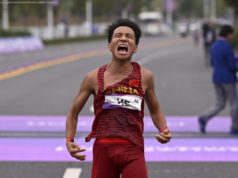Bosses say project, that will connect Hong Kong to Shenzhen and Guangzhou, is now 95 per cent complete
Hong Kong’s rail service provider, MTR Corp, is pressing ahead with tests of its first batch of high-speed trains amid an ongoing controversy to house a joint cross-border checkpoint at the terminus in West Kowloon.
The HK$84.4 billion project is now more than 95 per cent complete and is on track to meet its original commission deadline of the third quarter next year, Simon Tang, general manager of the project at the MTR said before allowing the public to see the new trains at a Shek Kong facility in Yuen Long on Saturday.
The rail operator revealed some of the features on its orange and silver carriages to the public, such as accessible toilets, two types of sockets for Hong Kong and the mainland, reversible seats and VIP reading lights. About 4,000 people are expected to visit the facility over the weekend.
The city’s terminus is tentatively labelled as “Hong Kong West Kowloon” on LED display boards on the trains, which connect to Shenzhen and Guangzhou in the first high-speed rail link connecting Hong Kong with the mainland’s intricate rail network.
Tang said the trains were being tested at a speed of 200km/h – the speed they will travel in Hong Kong – under a joint test with their mainland counterparts. They have a maximum speed of above 300km/h by design. The tests allowed technicians to check track control, power, signalling and communication systems before the official launch, he added.
“The tests are going well. We haven’t found any major problems so far,” he said.
The immigration checkpoint arrangement has been controversial in Hong Kong, as this would give mainland officers almost full jurisdiction over the zone leased to them at the West Kowloon terminus.
Opponents argue it contradicts Article 18 of the Basic Law, the city’s mini-constitution, which states that mainland Chinese laws shall not be applied in Hong Kong under the “one country, two systems” policy.
Kenny Leong, a Macau resident, arrived in the city early on Saturday for a glimpse of the new trains.
“It would be lot easier for me to travel within the Greater Bay Area [in southern China] with the high-speed rail in Hong Kong,” the logistics worker said, as he sometimes travelled to cities in Guangdong province after finishing morning meetings in Hong Kong.
“The high-speed train is quite eye-catching with a streamlined bullet head and a silver metallic body,” said Lysander Wong, a retired civil servant after a tour inside the carriages. But he said the facilities provided for disabled passengers were still insufficient, despite an accessible toilet and parking space for wheelchairs on each train.
Jamie Leung, a secondary student, was thrilled at the power sockets provided.
“I would be able to charge my phone and use a computer,” he said.
While visitors are excited about the new features of the French-designed made-in-China carriages, a dozen protesters from an activist body – Co-location Concern Group – showed up on Saturday, with some dressed up as People’s Liberation Army soldiers and others as political prisoners, to voice their concerns about the joint checkpoint.
“I am taking this political prisoner back to the mainland,” a protester dressed as a PLA officer shouted at the public.
The concern group urged the government to consider an alternative plan to move the joint checkpoint to Futian in Shenzhen, and let Hong Kong immigration officers handle immigration and customs on mainland soil instead.
But transport chief Frank Chan Fan dismissed such suggestions in a paper submitted to the Legislative Council, claiming it was not practical, and could not make the full use of the advantage of the rail link. The government is due to discuss the co-location issue on October 25 at Legco.






